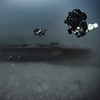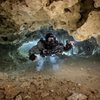TDI ADVANCED MIXED GAS CCR DIVER COURSE
The highest level of Closed Circuit Rebreather (CCR) training that TDI offers, the Advanced Mixed Gas Course will teach you how to use the full capabilities of a CCR. With a maximum depth of 100 metres/330 feet, this course opens up a whole new realm of diving including new wrecks, caves and walls to explore in depths you previously could not reach on a rebreather. This intensive course conducted over seven dives will focus on all the elements needed to plan and execute dives to these depths.
WHO IS THIS COURSE FOR
- The certified TDI Mixed Gas CCR Diver (or equivalent) looking to extend their depth limitations
COURSE PREREQUISITES
- Minimum age of 18
- Certified TDI CCR Mixed Gas Diluent diver, or equivalent from agencies recognized by TDI
- Have verified logs of a minimum of 100 hours as a certified CCR diver over a minimum of 100 dives; a minimum of 50 hours and 50 dives must be on the unit specific CCR. Fifty percent of these dives must be deeper than 30 metres/100 feet. All dives to be deeper than 9 metres/20 feet
- Appropriate theory for the course. This can be assigned to you on payment of the deposit
WHAT YOU CAN EXPECT TO LEARN
The TDI Diving Rebreathers Student Manual is required for use as a review/recap document. The instructor may use any additional text or materials they feel will represent the topic in an educational manner. The following topics must be covered during the course:
- Gas physiology
- Oxygen (O2) toxicity
- Hypoxia
- Nitrogen absorption
- Helium absorption
- HPNS
- Carbon dioxide (CO2) toxicity
- Gas consumption
- Gas mixing
- Formula Work
- Oxygen (O2) metabolizing calculations
- Manually controlled closed circuit rebreathers
- Equivalent narcosis depth theory
- Central nervous system (CNS) tracking
- Oxygen tracking units (out)
- Gas management
- Dive tables
- Creation of custom dive tables appropriate to dive depths
- Creation of lower percentage oxygen (PO2) diluent to support loop flushing and bailout at depth
- Dive computers
- Mix adjustable
- Constant partial pressure of oxygen (PPO2)
- Oxygen (O2) integrated
- Dive Planning
- Equipment Maintenance
- Fuel cell management
- Loop configurations
- Additional fitted equipment and modifications
REQUIRED SKILL PERFORMANCE
The following open water skills must be completed by the student during open water dives with the following course limits:
- No dives deeper than 100 metres/330 feet
- No dives shallower than 40 metres/130 feet other than the 1 air diluent configuration dive
- Equivalent narcosis depth not to exceed 30 metres/100 feet
- Calculate all off-board gas at litres 45.30/1.06 cubic feet per minute usage to cover stress situations
- PO2 not to exceed manufacturer recommendation or a working limit of 1.3 bar during the bottom phase of the dive and 1.4 bar during the decompression phase of the dive
- Diluent PO2 should not exceed 1.2 at maximum depth
- All dives to be completed within appropriate fixed PO2 decompression tables or decompression planning software
- All dives to be completed within CNS percentage limits with a recommend maximum of 80 percent of the total PO2 CNS limit
- The student is only certified for CCR mixed gas diving on the rebreather being used
PRE-DIVE DRILLS
- Conduct pre-dive checks using TDI Pre-flight checklist
- Use START* before every dive
- Stress analysis and mitigation
LAND DRILLS
- Build unit based on manufacturers specifications using manufacturers manual/build checklist
- Demonstrate familiarity with basic and intermediate hand signals
- Select and prepare equipment suitable for soft overhead environment with long decompression obligations
- Conduct team oriented drills for lift bag deployment and gas switching procedure
- Drills for buddy rescue
- Properly analyze all gas mixtures to be used
- Demonstrate adequate pre-dive planning
- Limits based on system performance
- Limits based on bailout gas requirements
- Limits based on oxygen exposures at chosen PPO2 levels
- Limits based on manually controlled closed circuit rebreathers
- Limits based on nitrogen absorption at planned depth and PPO2 (setpoint) level
- Limits based on helium absorption
- Correct narcotic depth planning and diluent selection to allow cell flushing at target depth (diluent should not exceed a PO2 of 1.2 at maximum planned depth)
IN-WATER DRILLS
- Show good awareness of buddy and other team members through communications, proximity and team oriented dive practices
- Demonstrate buoyancy control; ability to hover at fixed position in water column without moving hands or feet
- Properly execute a recovery from a system failure and conclude the dive and decompression on open circuit gases carried
- Properly execute a recovery from a system failure and conclude the dive and decompression with the unit in manual mode
- Gas shutdowns and loss of gas, correct choice and switching to off board gases
- Broken hoses, disaster scenarios
- Flooded absorbent canister
- Cell errors
- SCR drill (minimum of 10 minutes)
- Oxygen rebreather mode in depths less than 6 metres / 20 feet
- Manually control CCR Unit for one full dive including all decompression stops
- Demonstrate competence managing 3 bailout cylinders, including drop and recovery while maintaining position in the water column
- Demonstrate proper understanding and implementation of team bailout procedures and conduct a team bailout from a depth greater than 40 metres/130ft
- Demonstrate ability as a team to plug in and share off-board gas, including team sharing/swapping of off-board bailouts
- On 2 of the dives, demonstrate an ascent with ascent reel and lift bag and perform staged decompression
- Proper execution of the dive within all pre-determined dive limits
- Ability to manage multiple failures in adverse conditions
- Demonstrate of surface support/support divers in dealing with bailout scenarios
WHATS IN IT FOR YOU
Upon successful completion of this course, graduates may engage in technical diving activities utilizing the unit specific CCR to a maximum depth of 100 metres/330 feet utilizing any mixed gas diluent appropriate to the dive plan provided:
- The diving activities approximate those of training
- The areas of activities approximate those of training
- Environmental conditions approximate those of training
TDI CCR ADVANCED MIXED GAS BLENDER REQUIREMENTS
- Complete to the instructors satisfaction all in water skill development sessions
- Demonstrate mature, sound judgment concerning dive planning and execution
- Course must be completed within 6 weeks from the starting date
- Complete a refresher course following a period of inactivity greater than 6 months following the course
You can take the course on either on a JJ or Fathom/Gemini! If you would like more information on which one to choose please contact us directly via email to: info@techwise.com.mt
Human Factors in Diving: The essentials
This 3-hour online class is a great starting point to find out why we make mistakes and how we can reduce the likelihood of an accident or adverse event occurring. We dive into decision making, situational awareness, communication and cooperation skills, and crucially, their interdependence. Using case studies and practical exercise, we bring the topic to life. Want to gain a quick but valuable insight?
Contact us on info@techwise.com.mt for more information.
PAY YOUR DEPOSIT
To enrol onto this course, you will need to pay your deposit in advance so we can register and send you the course materials. You will need the materials to ensure you are prepared to start your training when you arrive at Techwise for your course. If this is what you want to do click DEPOSIT and then the BUY IT NOW button. *The full course price may be subjected to changes due to gas prices*





